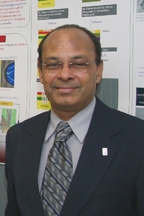Home > Press > Northeastern University Physicists Develop Nano-Optical Lens
 |
Abstract:
Using semiconductor nanotechnology, Srinivas Sridhar, Ph.D., Distinguished Professor and Chair of Physics at Northeastern University, and his team of researchers from the university's Electronic Materials Research Institute have created a new microlens that focuses infrared light at telecommunication frequencies. The focusing power of this microlens sets a world record for one of the shortest focal lengths ever achieved, focusing the infrared beam to a spot just 12 micrometers away from the surface. This represents an advance in light imaging technology and has the potential to lead to innovations in how current personal electronic devices are manufactured.
Northeastern University Physicists Develop Nano-Optical Lens
Boston, MA | Posted on August 26th, 2008The two-dimensional meta-material microlens, which uses the negative refractive index, was created by nano-engineering a photonic-crystal substrate into a multi-layered semiconducting wafer. The microlens focused infrared light to a location just 12 micrometers away from the lens surface - one of the shortest focal lengths recorded - at the limit of diffraction laws. In addition, the location of the focused light image was very sharp with little blurring.
"In order to go to the next level and create more efficient electronics, such as digital cameras, we need to explore ways to make things smaller," said Sridhar. "This research shows that it is possible to create smaller, ultra-compact infrared optical components that can be integrated into existing semiconductor technologies while not sacrificing image quality."
In addition to Sridhar, the team of researches involved with this project includes Bernard Didier F. Casse, Ph.D., Wentao Lu, Ph.D., and Yongjiang Huang, all from Northeastern's Physics department. The report was published in the August 7 edition of the journal Applied Physics Letters. This work was also supported by the Air Force Research Laboratories and the National Science Foundation.
"Light imaging technology is a crucial component to the field of optoelectronics, which uses light instead of electrons for carrying information, and represents the next generation of combined optical and electronic platforms essential for future computers," added Sridhar.
####
About Northeastern University
Founded in 1898, Northeastern University is a private research university located in the heart of Boston. Northeastern is a leader in interdisciplinary research, urban engagement, and the integration of classroom learning with real-world experience. The university’s distinctive cooperative education program, where students alternate semesters of full-time study with semesters of paid work in fields relevant to their professional interests and major, is one of the largest and most innovative in the world. The University offers a comprehensive range of undergraduate and graduate programs leading to degrees through the doctorate in six undergraduate colleges, eight graduate schools, and two part-time divisions.
For more information, please click here
Contacts:
Jenny Eriksen
(617) 373-2802
Copyright © Northeastern University
If you have a comment, please Contact us.Issuers of news releases, not 7th Wave, Inc. or Nanotechnology Now, are solely responsible for the accuracy of the content.
| Related News Press |
News and information
![]() Researchers develop molecular qubits that communicate at telecom frequencies October 3rd, 2025
Researchers develop molecular qubits that communicate at telecom frequencies October 3rd, 2025
![]() Next-generation quantum communication October 3rd, 2025
Next-generation quantum communication October 3rd, 2025
![]() "Nanoreactor" cage uses visible light for catalytic and ultra-selective cross-cycloadditions October 3rd, 2025
"Nanoreactor" cage uses visible light for catalytic and ultra-selective cross-cycloadditions October 3rd, 2025
Discoveries
![]() Researchers develop molecular qubits that communicate at telecom frequencies October 3rd, 2025
Researchers develop molecular qubits that communicate at telecom frequencies October 3rd, 2025
![]() Next-generation quantum communication October 3rd, 2025
Next-generation quantum communication October 3rd, 2025
![]() "Nanoreactor" cage uses visible light for catalytic and ultra-selective cross-cycloadditions October 3rd, 2025
"Nanoreactor" cage uses visible light for catalytic and ultra-selective cross-cycloadditions October 3rd, 2025
Announcements
![]() Rice membrane extracts lithium from brines with greater speed, less waste October 3rd, 2025
Rice membrane extracts lithium from brines with greater speed, less waste October 3rd, 2025
![]() Researchers develop molecular qubits that communicate at telecom frequencies October 3rd, 2025
Researchers develop molecular qubits that communicate at telecom frequencies October 3rd, 2025
![]() Next-generation quantum communication October 3rd, 2025
Next-generation quantum communication October 3rd, 2025
![]() "Nanoreactor" cage uses visible light for catalytic and ultra-selective cross-cycloadditions October 3rd, 2025
"Nanoreactor" cage uses visible light for catalytic and ultra-selective cross-cycloadditions October 3rd, 2025
Photonics/Optics/Lasers
![]() ICFO researchers overcome long-standing bottleneck in single photon detection with twisted 2D materials August 8th, 2025
ICFO researchers overcome long-standing bottleneck in single photon detection with twisted 2D materials August 8th, 2025
![]() Institute for Nanoscience hosts annual proposal planning meeting May 16th, 2025
Institute for Nanoscience hosts annual proposal planning meeting May 16th, 2025
|
|
||
|
|
||
| The latest news from around the world, FREE | ||
|
|
||
|
|
||
| Premium Products | ||
|
|
||
|
Only the news you want to read!
Learn More |
||
|
|
||
|
Full-service, expert consulting
Learn More |
||
|
|
||








